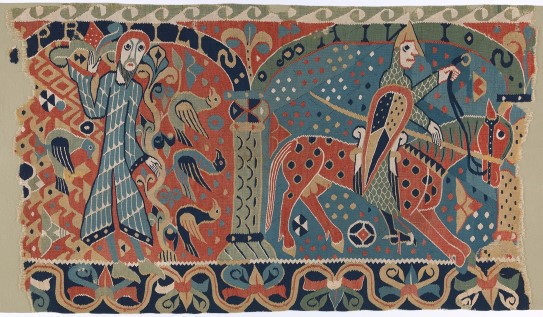Baldishol tapestry (audio description)
Unidentified artist
Transcription
Description
The Baldishol Tapestry
Probably from the second half of the 1100s.
The tapestry is about one meter high and two meters wide. The motif is divided into two main parts, where two bow shapes surround two men, one dressed in armor and a helmet on horseback, the other with birds around him. The colors red, green and blue dominate, borders and ornaments fill the image area.
Narrator:
Nes in Ringsaker, Innlandet, on the east side of the country, Lake Mjøsa, 1879.
Baldishol Church is going to be demolished. The congregation at Nes has grown, and a new church is to replace the old one. Objects and building materials from the old church are to be auctioned off.
Among the floorboards, a rolled-up woollen rag is discovered, caked in mud.
After the clay has been rinsed off, these two figures appear. A bearded man in a tunic, trees and birds, and letters spelling April over the man’s head. A knight in armour with shield and lance, sitting on his horse in the month May.
What else do we know?
The tapestry was woven in wool and linen sometime between 1150 and 1190. Possibly by a weaver in Norway, perhaps in a monastery, but it may also have been woven in a small workshop in England or France.
The torn edges suggest that it was once part of a longer tapestry. Perhaps a 12-metre-long tapestry of the 12 months of the year, which may have adorned and insulated a wall in a monastery, or perhaps a castle.
There are no other tapestries like this in the Nordic countries, and extremely few in Europe.
The Baldishol Tapestry is a mystery.
A famous mystery.
We know a little. Some questions we will never get answers to. But we know that, for a while, the tapestry warmed the sexton’s feet during the bitter cold of winter church services near Lake Mjøsa – and we see colours, details, lives and history woven into a tapestry from an age that no longer exists.